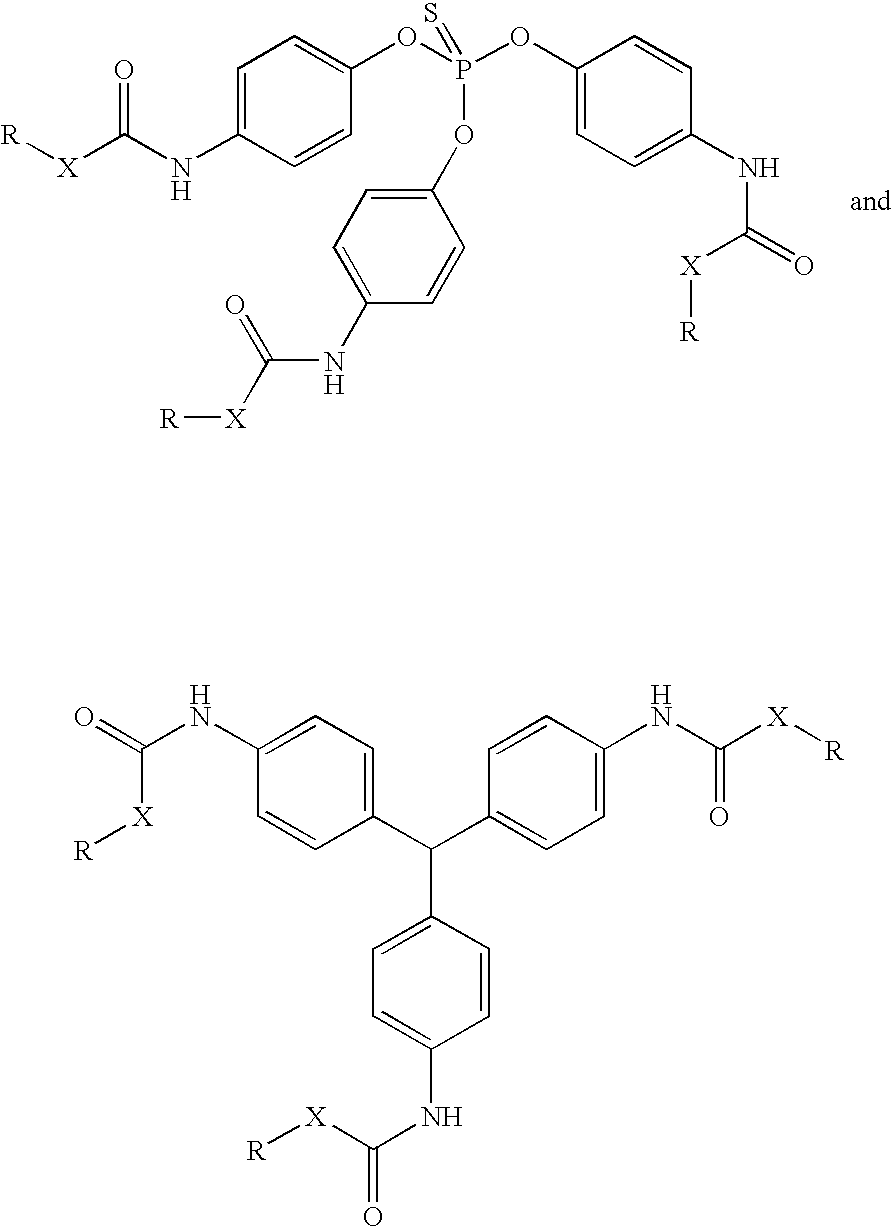Aromatic urethane acrylates having a high refractive index
a technology of urethane acrylates and olefin-unsaturated urethanes, which is applied in the direction of optical recording/reproducing/erasing methods, group 5/15 element organic compounds, and record information storage. it is not known the extent to which these are suitable for the production of data media, in particular those for holographic storage methods
- Summary
- Abstract
- Description
- Claims
- Application Information
AI Technical Summary
Benefits of technology
Problems solved by technology
Method used
Image
Examples
example 1
[0144]0.1 g of 2,6-di-tert-butyl-4-methylphenol, and 213.07 g of a 27% strength solution of tris(p-isocyanatophenyl) thiophosphate in ethyl acetate (Desmodure RFE, product of Bayer MaterialScience AG, Leverkusen, Germany) were initially introduced into a 500 ml round-bottomed flask and heated to 60° C. Thereafter, 42.37 g of 2-hydroxyethyl acrylate were added dropwise and the mixture was further kept at 60° C. until the isocyanate content had fallen below 0.1%. Thereafter, cooling was effected and the ethyl acetate was completely removed in vacuo. The product was obtained as a semicrystalline solid.
example 2
[0145]0.05 g of 2,6-di-tert-butyl-4-methylphenol, 0.015 g of dibutyltin dilaurate and 98.88 g of a 27% strength solution of tris(p-isocyanatophenyl) thiophosphate in ethyl acetate (Desmodur® RIFE, product of Bayer MaterialScience AG, Leverkusen, Germany) were initially introduced into a 250 ml round-bottomed flask and heated to 60° C. Thereafter, 9.83 g of 2-hydroxyethyl acrylate were added dropwise and the mixture was further kept at 60° C. until the isocyanate content had fallen below 3.3%. Thereafter, 13.41 g of 2-naphthalenemethanol were added dropwise and 60° C. was further maintained until the isocyanate content had fallen below 0.1%. Thereafter, cooling was effected and the ethyl acetate was completely removed in vacuo. The product was obtained as a semicrystalline solid.
example 3
[0146]0.15 g of 2,6-di-tert-butyl-4-methylphenol, 257.47 g of a 27% strength solution of tris(p-isocyanatophenyl)thiophosphate in ethyl acetate (Desmodur® RFE, product of Bayer MaterialScience AG, Leverkusen, Germany) were initially introduced into a 500 ml round-bottomed flask and heated to 60° C. Thereafter, 34.30 g of 2-hydroxyethyl acrylate were added dropwise and the mixture was further kept at 60° C. until the isocyanate content had fallen below 2.1%. Thereafter, 46.03 g of 4,4-isopropylidenebis[2-(2,6-dibromophenoxy)ethanol] were added dropwise and 60° C. was further maintained until the isocyanate content had fallen below 0.1%. Thereafter, cooling was effected and the ethyl acetate was completely removed in vacuo. The product was obtained as a semicrystalline solid.
PUM
| Property | Measurement | Unit |
|---|---|---|
| mol % | aaaaa | aaaaa |
| mol % | aaaaa | aaaaa |
| refractive index | aaaaa | aaaaa |
Abstract
Description
Claims
Application Information
 Login to View More
Login to View More - R&D
- Intellectual Property
- Life Sciences
- Materials
- Tech Scout
- Unparalleled Data Quality
- Higher Quality Content
- 60% Fewer Hallucinations
Browse by: Latest US Patents, China's latest patents, Technical Efficacy Thesaurus, Application Domain, Technology Topic, Popular Technical Reports.
© 2025 PatSnap. All rights reserved.Legal|Privacy policy|Modern Slavery Act Transparency Statement|Sitemap|About US| Contact US: help@patsnap.com



